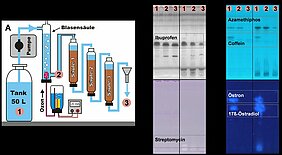The WBA-NTS-ProTrink project was intended to further develop the approach developed in a previous project of using effect-ditected analysis in combination with chemical analyses to assess organic micropollutants.
In the WBA-NTS-ProTrink research project, an effect-based assessment of drinking water treatment processes was developed. Effect-related analysis, a combination of fractionation using high-performance thin-layer chromatography and bioassay (HPTLC/WBA), was used for this purpose. The main aim of the project was to develop the necessary procedures and concepts to enable the evaluation of individual or combined treatment processes.
The laboratory test facility for continuous ozonation with slow sand filtration (COMBI) already used in the previous WBA-BeReit project was modified and expanded to include the treatment processes activated carbon filtration, advanced oxidation processes (AOPs) and chlorination-disinfection.
The further development of the enrichment methods used showed promising results, so that future methods can be used to extend the enrichable substance spectrum to include highly polar and ionic substances. The vacuum concentration tested in WBA-BeReit was extended by a step for matrix separation and enrichment, the so-called "salt-solvent extraction" (SLE), in order to separate the concentrated salt matrix and enrich the analytes to the required level. Despite current limitations in reproducibility, the basic suitability of the new method was demonstrated in small-scale experiments using organic anions. In contrast to pure vacuum concentration, the SLE extracts were compatible with the WBA.
Raw, process and drinking water from eleven water supply companies in Germany were analysed using both WBA and non-target screening (NTS). The results showed clear differences in the occurrence of effects in the raw water and process water samples, which revealed differences between the treatment processes used. Oxidative and microbial processes such as ozonation and bank filtration showed a predominantly good elimination of the detected effects. Filtration processes, on the other hand, hardly influenced the detected effects. For the use of chlorine disinfection, the formation of potentially genotoxic substances was observed, a structural elucidation of the active substances was not possible.
Furthermore, the existing HPTLC/WBA test battery was to be expanded to include the endpoints androgenicity (yeast androgen screen) and genotoxicity (umu assay). For a better quantitative classification of the potencies, a workflow was developed to determine the so-called biological equivalent concentrations (BEQ). Based on these values, an evaluation concept was proposed to assess the condition of the analysed water sample and the efficiency of the treatment processes. The trials carried out on the use of human cell lines in HPTLC/WBA were not successful overall and mainly revealed the limitations that still exist, such as the high time requirement or the difficulty in supplying the cells with nutrient solution.
The WBA evaluation concept could only be applied to a few real samples during the project. Routine and large-scale application of the WBA would allow the concept to be further honed and requirements to be adapted if necessary. A current limitation is the unsuccessful use of human cell lines in HPTLC/WBA. Further work should start here, as the significance of the results could be significantly increased and the detectable spectrum of activity could be expanded to include important substance classes, such as perfluorinated and polyfluorinated alkyl substances.

![[Translate to English:] Prüfstelle-Produktprüfung_Teststand Test centre and product testing](/fileadmin/_processed_/0/9/csm_TZW-Karlsruhe_Pruefung_Geraete-Teststand_377188946c.jpg)
























